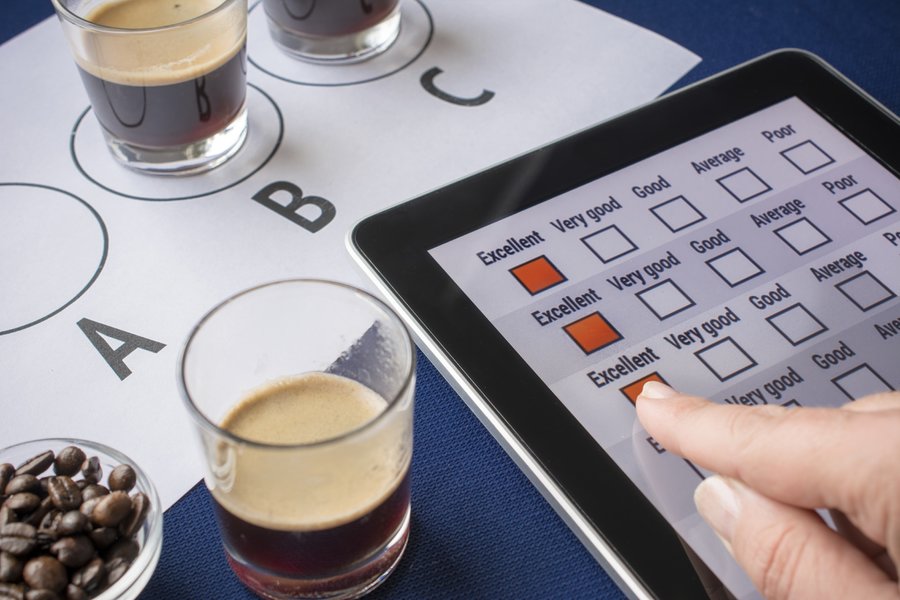ISO 4120 Triangle Sensory Testing in Food Products
The ISO 4120 Triangle Sensory Test is a standardized method used to evaluate the ability of human subjects to detect differences between three samples presented simultaneously. This test is particularly useful in food and feed testing as it helps identify sensory variations that may affect consumer acceptance, product consistency, or compliance with regulatory standards.
Food products are highly subjective by nature, making it essential for manufacturers to ensure their offerings meet quality expectations. The triangle test provides a reliable way to assess whether consumers can perceive differences in taste, aroma, texture, and other sensory attributes. This method is often used during product development, quality control, and regulatory compliance processes.
The triangle test involves presenting participants with three samples: two identical ones (control) and one different sample (target). Participants are asked to identify which sample does not belong with the others. A series of such tests allows for statistical analysis of the results, providing a quantifiable measure of sensory differentiation ability. This approach ensures consistent quality across batches while also helping brands stay ahead in market trends by detecting subtle differences that could impact consumer preferences.
The test is conducted under controlled conditions to minimize external factors influencing participants' responses. Proper training and familiarization with the procedure are crucial for accurate results, ensuring consistency among testers over time. By adhering strictly to ISO 4120 guidelines, laboratories can maintain high levels of reliability and validity in their sensory evaluations.
Using this method, companies gain valuable insights into consumer perceptions regarding their products, enabling them to make informed decisions about formulation changes or process improvements aimed at enhancing overall satisfaction. Additionally, it serves as an essential tool for enforcing compliance with international food safety regulations, helping ensure that all ingredients meet specified quality criteria before being introduced into the market.
Given its significance in maintaining product integrity and consumer trust, incorporating ISO 4120 Triangle Sensory Testing into regular operational procedures can significantly benefit organizations operating within the food sector. This practice not only enhances product quality but also contributes positively towards achieving sustainability goals by reducing waste and optimizing resource usage.
Scope and Methodology
The ISO 4120 Triangle Sensory Testing method encompasses a range of sensory attributes that can be evaluated, including taste, aroma, texture, appearance, and other relevant characteristics. The primary objective is to determine the minimum number of correct identifications required for participants to demonstrate reliable discrimination between samples.
During testing, each participant receives three samples labeled A, B, and C. Two out of these three will be identical (controls), while one will differ slightly from the others (target). Participants must identify which sample does not belong with the others based on their sensory perception.
To standardize results across different settings, laboratories follow strict procedures outlined in ISO 4120, including environmental conditions, equipment calibration, and personnel training. These measures ensure consistency in test outcomes and allow for accurate comparisons between samples.
The methodology also includes statistical analysis of the collected data to interpret performance metrics such as discrimination rate and detection threshold. This information helps laboratories make informed decisions about product development, quality assurance, and regulatory compliance strategies.
Industry Applications
| Sector | Application |
|---|---|
| Fine Dining Restaurants | Evaluating consistency in gourmet dishes to ensure each meal meets high standards. |
| Chef Schools | Teaching students about sensory evaluation techniques and their importance in culinary arts. |
| Beverage Manufacturers | Detecting minor variations in flavors or aromas that could impact customer satisfaction.|
| Packaging Companies | Ensuring proper labeling by verifying that packaging clearly indicates any differences between products. |
| Food Banks | Evaluating donated items to ensure quality before distribution, thus maintaining public trust. |
| Pharmaceutical Industry | Detecting off-flavors or other issues in drug formulations that could affect patient safety. |
| Consumer Research Firms | Conducting surveys to gauge consumer preferences and expectations regarding sensory attributes. |
The ISO 4120 Triangle Sensory Test is widely used across various sectors within the food industry, from fine dining restaurants to pharmaceutical firms. Its versatility makes it an indispensable tool for ensuring product quality, consistency, and regulatory compliance. By employing this standardized method, organizations can enhance their reputation while meeting stringent safety standards.
Use Cases and Application Examples
The ISO 4120 Triangle Sensory Test finds application in numerous scenarios within the food industry. One common use case involves quality assurance departments who require regular checks to monitor changes in product formulations over time. For instance, if a bakery introduces new ingredients into its recipes, it would be prudent to conduct sensory tests using this method before releasing the updated products to the market.
Another example comes from food safety agencies responsible for ensuring compliance with international standards like HACCP (Hazard Analysis and Critical Control Points). By incorporating ISO 4120 Triangle Sensory Testing into their inspection protocols, these organizations can more effectively detect potential issues early on in production processes.
In addition to these examples, the test also plays a crucial role during new product development stages. Companies often use it as part of market research efforts aimed at understanding consumer preferences and expectations regarding sensory attributes. Through this process, they can refine their offerings based on real-world feedback rather than relying solely on theoretical models.
Furthermore, ISO 4120 Triangle Sensory Testing proves valuable for companies engaged in product reformulation projects. By identifying subtle differences between previous versions and newly developed alternatives, manufacturers can ensure that improvements are made without compromising existing qualities.





